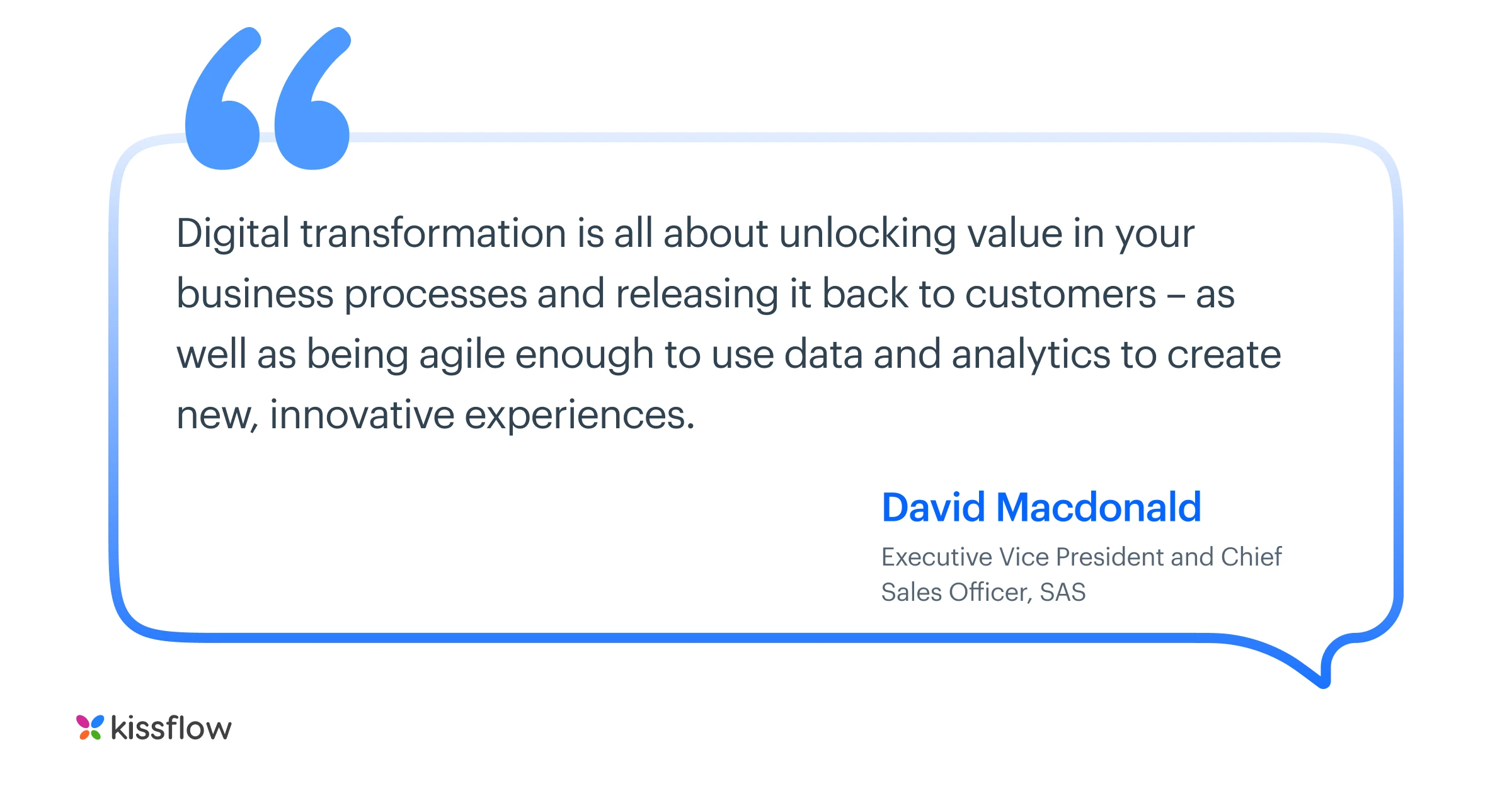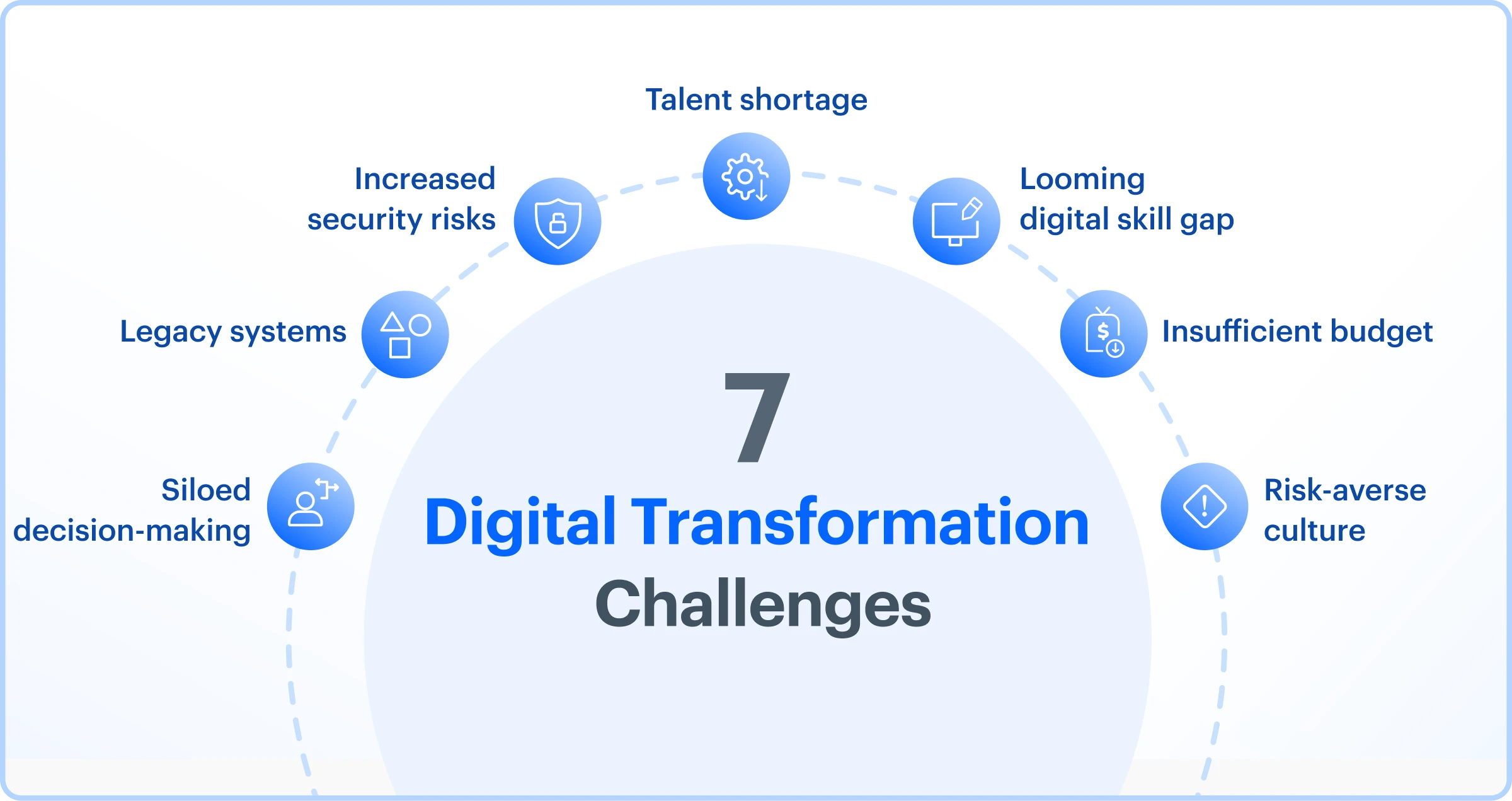
- >
- Digital transformation platform>
- Digital transformation challenges
Digital Transformation Challenges to Overcome in 2025
Team Kissflow
Updated on 13 Jun 2025 • 8 min read
Over the next few years, digital transformation is expected to be the top strategic business priority of enterprises in almost all industries. With 60 percent of CIOs and CTOs surveyed in a 2021 IBM study[1] indicating that their IT modernization program is not yet ready for the future, we see many fast-tracking their digital technology initiatives this year.
Digital transformation presents your organization with the opportunity to reimagine the way your business is run through the use of new digital processes and tools. However, there are challenges you need to face throughout every stage of the digital transformation process.

As a business leader, you must understand that digital transformation challenges are not always directly related to technological concerns or technical barriers. They also include people-centric issues, organizational structures, and other non-tech factors. The best way to overcome them is to identify and assess which specific problems affect your business.
7 Biggest Digital Transformation Challenges in 2025

1. Siloed decision-making
Organizational silos negatively impact digital transformation. They pose obstacles in almost every aspect of transformation, from strategy building to implementation.
Silos lead to disconnected decision-making as each team or department focuses on solving its own problems and achieving its own goals. The problem is compounded by a lack of unified vision that propels every team towards a common business goal. This then restricts efficiencies and impedes innovation within the organization.
2. Legacy systems
Even in business, moving out of your comfort zone is difficult. You can see this in enterprises still using legacy systems despite the availability of more agile and robust platforms. After all, they have invested substantial capital in these systems and are still reaping benefits from them.
However, with obsolete software and outdated technologies still powering them, these legacy systems are among the top bottlenecks in digital transformation service. They are often slow and inflexible, making it harder to adapt to transitions and integrate with new technologies. An even more pressing concern is their vulnerability to security breaches.

Your Guide on Embarking Digital Transformation: The Low-code Approach
Thank you for reaching us!
Thank you for reaching us!
3. Risk-averse organizational culture
A business culture that resists change impedes growth and development. Still, we see this risk-averse culture within many enterprises when it comes to digital transformation. From C-level executives to employees, there is some form of resistance to the adoption of new technologies. Some business leaders see no benefit in changing their tried-and-true practices especially if they are achieving positive results. Employees may feel uncertain about the new roles and responsibilities that come with digital transformation. By not addressing these issues, businesses risk losing crucial growth opportunities.
4. Insufficient budget for technological change
For businesses that faced significant losses during the pandemic, digital transformation solutions may have been set back due to financial constraints. The fact is, that implementing new digital initiatives is an expensive process that requires hefty investments.
Then, there’s also the misperception that technology expenditure is an operational expense. When businesses fail to see digital transformation as a strategic investment, they allocate insufficient budgets for it. Ultimately, this hinders proper implementation and impedes future agility and adaptability.
5. Looming digital skill gap
As businesses implement digitization within their organization, virtually every role will require some form of digital skills. Even non-technical positions will necessitate basic tech know-how. This leads to an insufficient breadth of digital skills required for successful transformation.
The digital skills gap is exacerbated by the scarcity of specialists in core competencies required for the shift. Expertise in analytics, cloud, cybersecurity, enterprise architecture, digital experience, and other areas is vital to digital transformation. Unfortunately, finding the right people in a limited talent pool can be daunting and even expensive.
6. Shortage of technological resources
Aside from the talent shortage, businesses today are also faced with a shortage in other resources crucial to the adoption of digital initiatives. The global microchip shortage still poses a roadblock to many industries. Then, there are still prevalent issues hampering the supply chain for IT hardware and equipment. The shortage inhibits the timely deployment of adequate resources to the right initiatives.
7. Increased security risks
To adapt to the sudden changes in consumer demands, many companies rushed the implementation of digital solutions. This made them vulnerable to increased cybersecurity risks. This also made other businesses wary of experiencing the same breaches when they implement their own initiatives.
The fear is not unwarranted though. Working with dozens of SaaS vendors is a daunting task. Verifying the security level of each third-party platform and tool is a great challenge even for enterprises with a solid tech dev team.
Tips to Overcome Digital Transformation Challenges
Digital transformation challenges can be overwhelming, with some factors being beyond your control. As per the BCG's report, digital transformation failure rate is very high, It is must to take some steps to overcome them and lead your organization to a smooth and seamless transition to a digital future. Here are 10 Tips to overcome the barriers.
1. Align your digital transformation programs with business outcomes
One of the first steps to a successful digital shift is aligning your initiatives with business outcomes. Prioritize digital investments that impact specific goals. Use outcome-driven criteria to determine where to allocate your budget and which programs to focus on. Create a unified vision that reflects your business priorities.
2. Make organizational change a core element of digital transformation
Organizational change may be difficult but it is crucial for transformational growth. This involves a culture change with a company-wide shift in mindset.
Start by assessing cultural impediments to digital transformation. Then, implement a change management strategy with a comprehensive and unified roadmap. Keep in mind that change must start from the top. This is essential for minimizing resistance from your employees.
3. Maintain transparent communication at all levels
A recent Gartner survey shows that 65 percent of decisions made today are more complex[2] than those in previous years. They involve more options and more stakeholders in the decision-making process.
To enable sound decision-making, you must maintain transparent communication and keep feedback loops open with all stakeholders. This will help remove data silos and make business decisions more contextual.
4. Craft a solid implementation plan
Your vision for a digital future must be backed by a solid implementation plan. Your technology roadmap should support your initiatives and ensure consistency across all areas. To drive sustainable adoption, craft a strategy for the integration of scalable systems for enterprise architecture, cybersecurity, cloud solutions, analytics, and others.
5. Strategize technology procurement plans
Budgets can be managed internally but shortages in other resources are often beyond your control. To reduce bottlenecks during your transition, plan a well-defined strategy for technology procurement.
Conduct a technology assessment to evaluate your existing tech and determine new solutions vital to your digital shift. Look for alternative solutions whenever possible. Include tech resource shortages in your risk management plan to mitigate potential risks.
6. Bridge the skills gap
Build digital dexterity by investing in education and training for the upskilling of your workforce. This will ensure that they have the requisite skills and capabilities to adapt to the digital shift and effectively integrate digital tools into their work processes. Aside from closing the digital skills gap, this also empowers your employees and motivates them to improve their performance.
7. Broaden sourcing criteria
Another way to bridge the digital skills gap is to broaden our sourcing criteria. Expand your talent pool by looking for digital skills outside of IT functions or by accessing the global talent pool. Invest in systems that enable the adoption of a distributed workforce. You can also consider outsourcing projects to external teams with the required technical proficiency.
8. Enhance your cybersecurity strategy
Achieving secure digital transformation requires continuous improvement of your cybersecurity capabilities. Make sure you have a proactive monitoring strategy to resolve issues before they turn into high-risk breaches. Implement patch management to identify vulnerabilities when using third-party applications.
Your cybersecurity strategy must be a core element of your transformation program. It will also require a reasonable budget to implement effective security measures. Still, the cost of mitigating risks will undoubtedly be higher. So, ensure that you have risk management frameworks and cybersecurity measures in place.
9. Have a comprehensive financial strategy
Implementing new digital solutions is costly but necessary for business growth. However, improper planning and management can cause you to exceed your budget allocation. Avoid this by having a comprehensive financial strategy for your digital transformation. Calculate the expected costs, potential long-term benefits, and investment returns before implementing the transformation. Consider also additional costs your digital shift will entail as your business grows.
10. Implement low or no-code solutions
One of the easiest ways to overcome digital transformation challenges is by implementing low-code or no-code solutions. Aside from avoiding employee pushback towards new digital solutions, these enable employees to leverage new technology without needing specialized tech skills. Check out how building custom apps and processes using the low code platform like Kissflow to mitigates the barriers in accelerating the digital transformation journey.
Case Study: First Philippine Holdings Transforms Workflow Management with Kissflow
First Philippine Holdings (FPH) faced a significant challenge during the pandemic - the need to digitize and streamline their operations while minimizing their carbon footprint. Manual processes, lack of centralized tracking, and delayed approvals were hindering their progress. Joseph Arnel Chavez, Assistant Manager at FPH, spearheaded the search for a solution that would bring efficiency, speed, and sustainability to their workflow management.
Choosing Kissflow:
After evaluating multiple tools, Joseph chose Kissflow. The platform offered a user-friendly interface and competitive pricing and was already familiar to the senior management, as one of FPH's principal subsidiaries, Energy Development Corporation, was using it.
Implementation:
With Kissflow, FPH achieved its first major victory by going paperless, aligning its operations with its sustainability goals. They were able to digitize a wide range of processes, from accounts payable and billing to vendor accreditation and admin requests - all without the need for developer or IT Leaders. They successfully automated over 100 office processes, reducing the time and effort spent on manual tasks.
Overcoming Challenges:
Before implementing Kissflow, FPH struggled with managing over 1,000 approval requests, which were difficult to track across emails, physical forms, and SAP software. With Kissflow, they could centralize all approvals, eliminating the risk of losing requests. The mobile app also facilitated quicker approvals from senior leaders.
Get started with Kissflow Platform and learn how to leverage its features to drive better results
Results:
Kissflow enabled FPH to significantly reduce its carbon footprint and automate over 100 office processes. They now process over 1,000 paperless approvals monthly, enhancing operational efficiency and customer service.
Looking Ahead:
FPH plans to leverage Kissflow's integrations to unify processes across different tools. They are also keen to use the external portal feature to improve visibility into vendor operations.
Joseph sums up the impact of Kissflow on FPH: "Our partnership with Kissflow helps improve operational and process efficiency that, in turn, enhances how we serve our customers and vendors. At the same time, the partnership reaffirms the relevance of the FPH Group’s new mission of ‘forging collaborative pathways for a decarbonized and regenerative future."
This case study underscores how Kissflow can transform business operations, streamline processes, enhance efficiency, and support sustainability goals.
Removing Digital Transformation Barriers
Successful digital transformation is not just about implementing digital technologies. Adopting the latest cutting-edge technology alone does not guarantee success. You will encounter several internal and external challenges that can impede the transformation.
Businesses are unable to invest in digital transformation moves due to the losses incurred during the pandemic, which stands as a huge barrier to digital transformation. The adoption of digital solutions is an expensive process and requires hefty investments.
Still, you can overcome these challenges by eliminating the roadblocks to change. Instill changes in your organizational structure and culture. Utilize flexible architecture that can handle diverse technologies. Most importantly, find the right digital transformation platform like Kissflow that can help you build a scalable business.
Frequently Asked Questions
1. What are the biggest obstacles to digital transformation?
The biggest obstacles to digital transformation include organizational resistance to change, legacy system integration challenges, data silos preventing unified customer views, inadequate digital skills among employees, security and compliance concerns, unclear ROI measurements, and leadership misalignment on transformation priorities. Cultural factors often present greater challenges than technological ones.
2. How can businesses successfully transition to digital?
Successful digital transition strategies include creating a clear transformation roadmap with measurable milestones, securing executive sponsorship and visible leadership commitment, investing in employee digital skills development, starting with high-impact pilot projects to demonstrate value, implementing change management programs addressing cultural resistance, ensuring technology decisions align with business goals, and establishing metrics to track transformation progress.
3. What role does AI play in overcoming digital transformation challenges?
AI helps overcome digital transformation challenges by accelerating process automation to demonstrate quick wins, providing data-driven insights that build transformation business cases, personalizing change management approaches for different employee segments, augmenting workforce capabilities to address skill gaps, optimizing resource allocation across transformation initiatives, and enabling more natural human-computer interaction that improves adoption.
4. What industries struggle the most with digital transformation?
Industries struggling most with digital transformation include healthcare (complex regulatory environment, legacy systems), manufacturing (extensive physical assets, traditional cultures), public sector (budget constraints, procurement complexity), education (institutional inertia, funding challenges), and utilities (regulated markets, critical infrastructure security concerns). These sectors face structural barriers beyond typical change management issues.
5. What strategies help businesses overcome digital transformation roadblocks?
Strategies for overcoming digital transformation roadblocks include creating a compelling change narrative focused on benefits, securing visible executive sponsorship, establishing cross-functional teams with decision authority, implementing quick-win projects that demonstrate value, investing in employee digital skills, adopting a test-and-learn approach that embraces productive failure, and establishing clear metrics to track progress and maintain momentum.
Discover effective solutions to overcome your digital transformation challenges
Related Articles



-4.webp)









